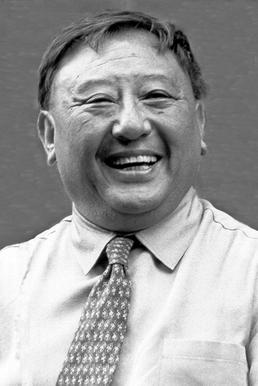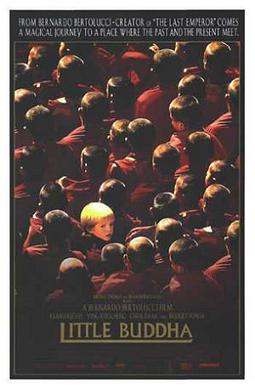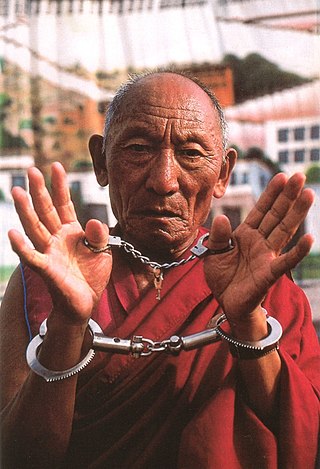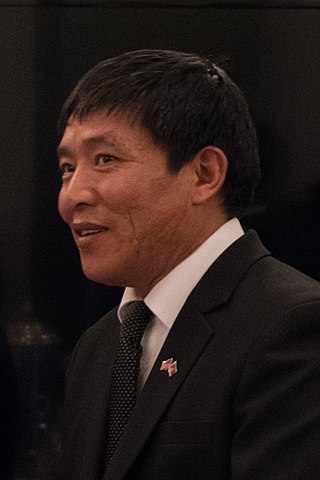
Diana Vreeland was an American fashion columnist and editor. She worked for the fashion magazine Harper's Bazaar and as editor-in-chief at Vogue, later becoming a special consultant to the Costume Institute of the Metropolitan Museum of Art. She was named on the International Best Dressed List Hall of Fame in 1964. Vreeland coined the term youthquake in 1965.

Kyabje Nawang Gehlek Rimpoche was a Tibetan Buddhist lama born in Lhasa, Tibet on October 26, 1939. His personal name was Gelek; kyabje and rimpoche are titles meaning "teacher" and "precious," respectively; he is known to Tibetans as Nyakre Khentrul Rinpoche. According to Thupten Jinpa, principal English translator to the Dalai Lama, he is considered
"an important link to the great lineages of Tibet’s great masters, especially of the Geluk school. Known more famously for the Tibetans as Nyakre Khentrul Rinpoche, Rinpoche had been instrumental in reprinting many of the Geluk texts in the 1970s, and also remained an important object of affection for both Kyabje Ling Rinpoche and Kyabje Trijang Rinpoche. Of course, his emergence as one of the great Tibetan teachers in the West has also been a source of inspiration for many.”

Little Buddha is a 1993 drama film directed by Bernardo Bertolucci, written by Rudy Wurlitzer and Mark Peploe, and produced by usual Bertolucci collaborator Jeremy Thomas. An international co-production of Italy, France and the United Kingdom, the film stars Chris Isaak, Bridget Fonda and Keanu Reeves as Prince Siddhartha.

Sera Monastery is one of the "great three" Gelug university monasteries of Tibet, located 1.25 miles (2.01 km) north of Lhasa and about 5 km (3.1 mi) north of the Jokhang.

Drepung Monastery, located at the foot of Mount Gephel, is one of the "great three" Gelug university gompas (monasteries) of Tibet. The other two are Ganden Monastery and Sera Monastery.

Monlam, also known as The Great Prayer Festival, falls on the 4th to 11th day of the 1st Tibetan month in Tibetan Buddhism.

Palden Gyatso was a Tibetan Buddhist monk. Arrested for protesting during the Chinese invasion of Tibet, he spent 33 years in Chinese prisons and labor camps, where he was extensively tortured, and served the longest term of any Tibetan political prisoner. After his release in 1992 he fled to Dharamsala in North India, in exile. He was still a practicing monk and became a political activist, traveling the world publicizing the cause of Tibet up until his death in 2018. His autobiography Fire Under the Snow is also known as The Autobiography of a Tibetan Monk. He was the subject of the 2008 documentary film Fire Under the Snow.
The 1987–1989 Tibetan unrest was a series of protests and demonstrations that called for Tibetan independence. These protests took place between September 1987 and March 1989 in the Tibet Autonomous Region, in the Tibetan regions of Sichuan, and Qinghai, as well as the Tibetan prefectures in Yunnan and Gansu. Protests began shortly after the Dalai Lama, the religious and temporal leader of Tibet exiled in India since the 1959 Tibetan unrest, proposed a Five Point Peace Plan regarding the “status of Tibet” on September 21, 1987, which was subsequently rejected by the Chinese government. The Plan advocated for greater respect and autonomy of the Tibetan people, and claimed that “Tibet was a fully independent state when the People’s Liberation Army invaded the country in 1949-50.” China rejected the idea of Tibetans as an invaded people, stating that “Tibet is an inalienable part of Chinese territory” and has been for hundreds of years. The Tibetan sovereignty debate is longstanding, and the Tibetan assertion that they are a separate and unique people invaded by China has become a central argument for their independence.

Lina Dorado is a contemporary artist and filmmaker based in New York City noted for her multimedia work and travel photography, Lina Dorado has authored two books in bilingual editions: Doble Vista / Second Sight and Drawing Only, Solo Dibujo alongside her long-term collaborator: Luis Cantillo. Their book Doble Vista / Second Sight written by Dorado and photographs by both was acquired by the New York Public Library Museum of Modern Art in New York MOMA and the Whitney Museum for their Artists' Books Collection. In August 2018 her first feature film Pelucas y Rokanrol was theatrically released in Colombia, the film was directed by Mario Duarte and written by Mario Duarte and Lina Dorado.

Rato Dratsang, also known as Rato Monastery, Rato Dratsang is a Tibetan Buddhist monastery of the Gelug or "Yellow Hat" order. For many centuries, Rato Dratsang was an important monastic center of Buddhist studies in Central Tibet.
Chone Monastery, also Chone Gonchen Ganden Shedrubling, or Choni Monastery was originally a Sakya monastery. It is situated adjacent to Liulin, Jonê County, Gannan Tibetan Autonomous Prefecture, Gansu Province, China, at an altitude of about 2,610 m (8,563 ft).

Dhondup Wangchen is a Tibetan filmmaker imprisoned by the Chinese government in 2008 on charges related to his documentary Leaving Fear Behind. Made with senior Tibetan monk Jigme Gyatso, the documentary consists of interviews with ordinary Tibetan people discussing the 14th Dalai Lama, the Chinese government, the 2008 Beijing Olympics, and Han Chinese migrants to the region. After smuggling the tapes of the interviews out of Tibet, however, Dhondup Wangchen and Jigme Gyatso were detained during the 2008 Tibetan unrest.

Khyongla Rato, pronounced "Chungla," was also known as Khyongla Rato Rinpoche, Rato Khyongla Rinpoche, Khyongla Rinpoche, Ngawang Lobsang Shedrub Tenpai Dronme, and Nawang Losang, his monk's name. Born in Dagyab county in Kham province in southeastern Tibet, he was recognized as an incarnate lama at an early age. He spent over 30 years receiving teachings and studying as a highly trained monk in the Tibetan Buddhist monasteries of Tibet. A respected scholar, he was a debate partner of the 14th Dalai Lama at his Geshe examination in Lhasa, Tibet. He founded the Tibet Center in New York City. The center co-sponsored many of the Dalai Lama's teachings in New York City.

The Tibet Center, also known as Kunkhyab Thardo Ling, is a dharma center for the study of Tibetan Buddhism. Founded by Venerable Khyongla Rato Rinpoche in 1975, it is one of the oldest Tibetan Buddhist centers in New York City. The current director is Khen Rinpoche Nicholas Vreeland, the abbot of Rato Dratsang monastery. Philip Glass assisted with the founding of The Tibet Center. Since 1991 TTC has invited and hosted the 14th Dalai Lama for teaching events in New York in partnership with the Gere Foundation.

Nicholas Vreeland, also known as Rato Khensur Thupten Lhundup, is a Tibetan Buddhist monk and the former abbot of Rato Dratsang, a 14th-century Tibetan Buddhist monastery reestablished in India. Vreeland is also a photographer. He is the son of Ambassador Frederick Vreeland and grandson of Diana Vreeland, former editor-in-chief of Vogue magazine and special consultant to The Metropolitan Museum of Art's Costume Institute, where she set the "standard for costume exhibitions globally."

Guido Santi was a filmmaker, director and producer who was born in Genoa, Italy, on May 9, 1962. He lived and worked in Los Angeles, where he also taught at the College of the Canyons.

Tina Mascara is an American director, producer and writer. She is best known for her documentary films, especially the two biographical documentaries which were made with her husband Guido Santi.

My Life and Lives: Khyongla Rato, The Story of a Tibetan Incarnation is the autobiography of Khyongla Rato Rinpoche, a Tibetan Buddhist scholar and teacher. Rato was an incarnate lama who was born in the Kham district of Tibet in 1923. The introduction to the book was written by the mythologist Joseph Campbell, who also edited the book. My Life and Lives was first published in 1977, and a second edition was published in 1991.

Yeshi Dhonden was a Tibetan doctor of traditional Tibetan medicine, and served the 14th Dalai Lama from 1961 to 1980. In 2018, the Indian government honoured him with the Padma Shri, the fourth highest civilian award in India.


















